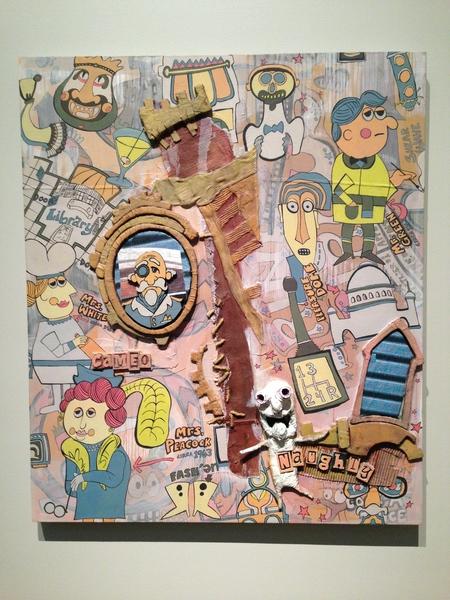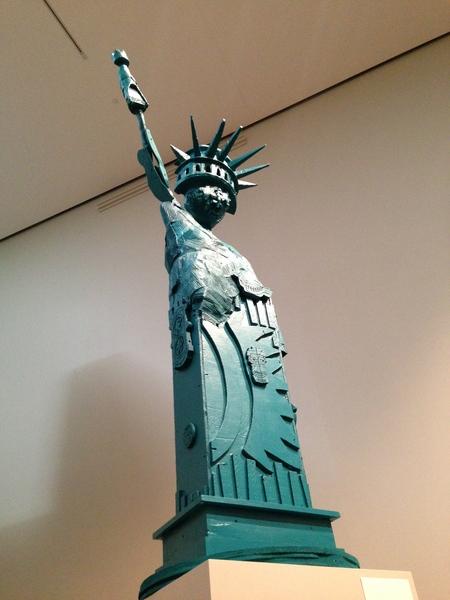
I do understand why museums intimidate us: We feel as if we won’t “get” what is meant to be gotten. But well-curated museums provide a broader experience than we often allow ourselves to have. What if we allowed our own interpretation to be the main goal? When there's nothing to “get” other than our own perspective, a museum visit can uncover a simple contentment, peace of mind, and happiness.
On a recent, typical July afternoon that reached upwards of 100 degrees, I had the pleasure of pacing myself through the cool (both temperature- and aesthetics-wise) Figge Art Museum in downtown Davenport. The building itself is a work of art worth seeing. While the Figge's sheer exterior is disciplined and daunting to some, the layout and galleries are kind, open, and invite wonder. First-time visitors will be wowed by the clean, crisp infrastructure and grand galleries, lobbies, and landings. From the entrance to the top floor, the staff was eager to assist, and after a quick map pick-up, I was ready to explore.
“Children do live in fantasy and reality; they move back and forth very easily in a way we no longer remember how to do.” – Maurice Sendak
Highly anticipating Where the Wild Things Are Maurice Sendak: The Memorial Exhibition 50 Years, 50 Works, 50 Reasons (on view through August 7), I started in the Katz Gallery on the second floor. Child’s play, I tell you. Talk about taking a stroll back into a playful and creative mind space. I felt like I shrunk down to my seven-year-old self, adorned in my favorite patent-leather shoes and sparkly red costume dress. “Let the wild rumpus start!” was on the tip of my tongue and laugh lines visibly present as I stepped from piece to piece. The multi-media exhibit featured pre-Wild Things pencil drawings for a Medievally themed book, early illustrations of our favorite monsters and Max, and sculptures from admiring artists, as well as drawings made for friends and fans. The play station that mimics the book's iconic tents sparked a kid-ish charm in all ages that were immersed in the Sendak universe. Toddlers were running and giggling, college-age students were wide-eyed with curiosity, and baby boomers were reunited with their youth. Maurice Sendak, meanwhile, remains undefeated in reuniting us with our imagination.
“My work deals with … how a space can be a combination of both interior and exterior.” – Alois Kronschlaeger
Walking into the third-floor gallery, a certain mellowness takes over. Alois Kronschlaeger’s Figge-specific sculpture exhibition titled Polychromatic Contemplations (on view through September 16) was tranquil and settling. Each one of the free-standing assemblages was dramatically and subtly lit from above. Early stages of skyscrapers come to mind, and one can walk freely amidst the dense grid of floor-mounted pieces – some only knee-high, others 12-plus feet in the air. Kronschlaeger (born in Austria in 1966, currently residing in Brooklyn, New York) erects geometric see-through labyrinths of thin wood strips, some adorned with string art and woven fabric, and others invaded by cloud-shaped metal mesh. There are several nods to the Figge building's exterior, invoking architect David Chipperfield, and some of the pieces were mounted atop a honeycomb-like stacking of pavers also used for the Figge's exterior grounds. The artist cleverly paints purposeful colors on each side of the tiny balsa wood frames, interwining shapes within shapes. The effect challenges the viewer to bend and move around each sculpture to see which suspenseful illusion emerges. Like the Figge building itself, these sculptures are stark and linear at first glance, but open up worlds of possibilities within their interiors. Kronschlaeger's Contemplations showcases how art can alter our reality, and how art is the champion and winner of all medals in regards to escapism – for which we're all due a bit more.
Walking in between the galleries you can experience one of the best Mississippi River views any downtown building has to offer. Sinking into the seating I was able to really dial open my ears to the stillness that surrounded me. While the traditional purpose of an art museum is for art to reside and breathe, it’s also a place to take in what you’re not used to. In my case, inactivity and an absence of motion were very welcome. While visitors study and side-step from piece to piece, shuffling from gallery to gallery, there is a lack of furrowed brows that we’ve become so accustomed to seeing. Museums such as the Figge bury our anxieties and offer a world we deserve – a calm and authentic space effective for simply existing.
After enjoying the sweeping riverfront views from within this multi-story Zen-zone, it was time to see the original purpose for my visit: Steve Banks: Pop Culture Palimpsest (on view through September 2).
Those coming off the elevator to the fourth-floor gallery are roundly greeted by a 14-foot-tall rendition of Mr. Peanut tipping his top hat, holding his cane out in gesture. This iconic advertising pitch peanut is elevated to museum status within the gallery foyer, despite being created from wood scraps, fabric, chicken wire, cardboard, and expanding foam. Take the Winter Garden stairs to the top floor, and your first view in the exhibit is Mr. Peanut's hollow posterior body cavity, revealing Banks' nutty craftsmanship.
Banks, who lives and has a studio mere blocks from the Figge, extends an invitation to take a closer look at our homegrown relationship with media and pop-culture. We all recognize Mr Peanut, but why? The answer is a whimsical jungle gym that explores how and why mass-consumption messaging vies to shape our identities. A proper primer is in the posted exhibit introduction by Marshall McLuhan: “The medium is the message, the medium is the mess age, the Medium is the Massage.”

The exhibition holds close to 30 pieces, including four sculptures, utilizing a wide variety of mediums: hot glue, fabric, cardboard, cement, liquid nails, plastic toys, carved wood, hand-built ceramics including tiny bricks, metal, canvas, old billboard material … and cigarette butts. The result is provocative, enticing, and playful imagery. While his work boasts heavily on recycled materials, his concepts shout originality. Banks is a draftsman, painter, and textile artist, literally and figuratively providing powerful starting points for sifting through a meaningful process.
The complexity of textures, deft political parody, and layers of recognizable caricatures brought forth by consumerism all kick-start a right-brain-versus-left-brain battle – an army of creativity, feelings, and imagination confronting logic, strategy, and analytic reasoning. The exhibit is grandiose in size, content, and color, and many of the paintings are encompassed with elaborate wooden frames made up of words, landscapes, and characters, all meticulously carved with legions of Dremel tools. Just within the frame itself, you can get lost in the intricately designed adventure maps.
Palimpsest is reference to an ancient method of reusing parchment that left prior layers salvagable. This layering, or revealing of iterations, is most refreshingly understood in the title cards, where the prior titles of the piece are hand-written in and crossed out. Art is a living and breathing entity, and it grows and changes just like everything else. When that maturation process is recognized effectively, as in the title cards, the work generates even more connections.
The exhibit's centerpiece, titled Processionalization: Power Lunch with the Tasaday, is a 20-foot-wide mural resembling both rusty metal and clay, and outlining a relief storyboard inside five panels. Blanketing the wood floor directly below the mural from end to end is an avalanche of hand-built ceramic detritus. From Dagwood-style sandwiches to classical ionic pillars, and from tribal masks to suction-pod groupings, this pile of pottery shards is also Banks' ceramic boneyard for the elements.
This sepia toned mural and ceramic tsunami is flanked by two towering mixed-media sculptures. One is a mostly wooden figure astride a rearing horse with lance extended high in the air. Ostensibly, this Quioxtian figure is here because of the 20-foot-tall windmill amidst the paintings on the other side of the gallery. The other piece flanking the mural is an aqua blue Statue of Liberty proudly astride a waist-high pedestal. Lady Liberty's dress is corrugated cardboard, but the paint job and gluing medium give it a carved wet-clay feel. She has a sly optimism about her as she gazes down at visitors beneath her oversize crown.
After standing and processing, I shared with Steve the narrative I had formed behind the mural and ceramics installation. Learning Steve's inspiration and objective behind his allegorical ode to a lost tribe in the Philipines stands tall in this Figge visit. It was comforting to be validated for a perspective differing from the artist. Banks wants the audience to form and enjoy their own personal experiences. Life's many facets tell us what we're doing right or wrong. Here, in this space, you can unapologetically think and feel however you’d like. I walk away feeling victorious.
It's with exhibits such as these three that we realize art does make us happy. Disarm conventional expectations about art museums, and allow yourself to genuinely appreciate the entire experience. There's no excuses through August 12, as admittance (normally $7/adult and $4/child) is free, and it's always free after 5pm on Thursdays. For more information, visit FiggeArtMuseum.org.










